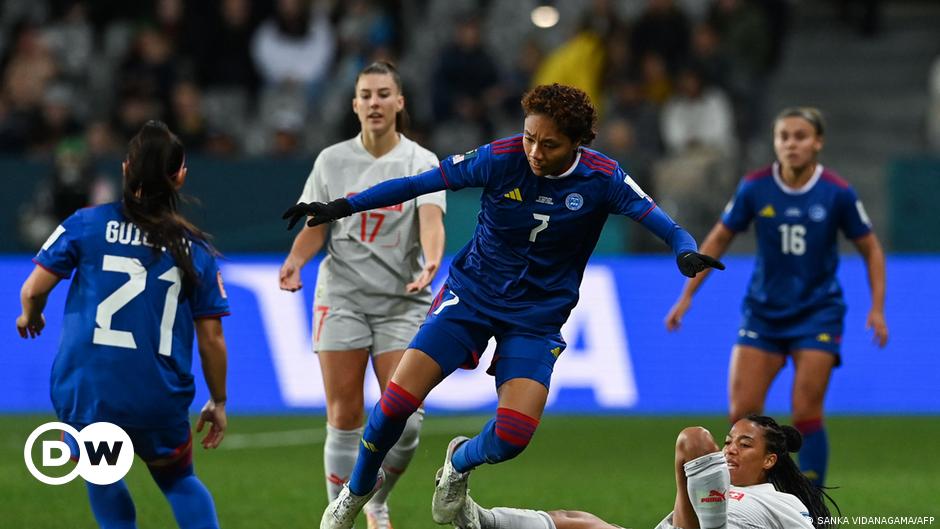World Cup: How the Philippines ’embody essence of soccer’ – DW – 07/23/2023
There has never been a World Cup team quite like the Philippines.
While it is hardly uncommon in football for players to represent a different country to the one they were born and raised in, having 22 such players in a 23-woman squad is unheard of.
Or at least it was, until the Filipinas arrived in New Zealand for their debut World Cup appearance with midfielder Anicka Castaneda as the archipelago nation’s only home-grown talent.
Castaneda’s teammates hail predominantly from the United States (18 squad members), but there are also players born in Canada (1), Australia (1) and Norway (2), with the latter drawn in Group A alongside the Philippines.
In club football the perceived necessity for a core group of a team’s players to be from the local area, in order to connect with the fans and the values of the institution, has long since disappeared, even if individual examples are still highly romanticized. In international football though, a sense of national pride and the bonds of a shared upbringing are still often considered crucial to building team spirit.
‘It doesn’t matter where we were born’
But in the case of the Philippines, star forward Sarina Bolden, originally from California insists the players are able to channel the power of their common heritage.
“It doesn’t really matter where we were born because we’ve all had this one thing connecting us, and that’s being Filipino,” she says. “So in the locker room, we’re able to connect, get the morale up, no matter what.”
Her coach Alen Stajcic agrees. “Ultimately they all have Filipino blood, they all love their country, they all love their heritage, they all love their culture, so getting the bond is actually not difficult,” he says
Bolden and Stajcic are speaking to DW at a meet-and-greet event in Auckland, New Zealand, where the team are meeting local supporters, signing autographs and taking selfies.
Several fans are carrying Philippine flags, suggesting that some of the younger supporters present may be the children and grandchildren of Filipinos, much like their idols standing in front of them. For Bolden, interactions like these are nothing new.
“The one thing that I personally have learned is that Filipinos are everywhere!” she says. “Everywhere in the world, every place that we’ve gone so far, there’ve been people supporting us.”

Introducing the Philippine diaspora
The vast Philippine diaspora has seen millions of people emigrate to Europe, the Middle East and, most of all, North America. For a variety of reasons, including the fact that the Philippines was a US colony between 1902-1946, the most common destination by far has been the United States.
The US influence in the first half of the 20th century helped establish basketball as the most popular sport in the Philippines, while the relatively early growth of women’s football in the States came long after the end of the colonial period. So in some ways it should be no surprise that American-born players have now become fixtures in the Philippines side.
Coach Stajcic has witnessed the opposite phenomenon in his home country. As an Australian with Serbian heritage, he has been part of a football scene largely driven by immigrants from Europe and their descendants.
“Growing up in Australia, it’s full of immigrants and sometimes the passion for the country that the people left is even greater than the ones who have stayed behind,” he tells DW, adding that he senses that same feeling in his players.
“There is an unbelievable passion for the country, and a level of gratitude and humility which I haven’t seen in many other teams in the world,” he explains. “That makes it probably one of the best cultures of teams that I’ve ever worked in.”

‘Wow! This team has com a long way!’
The Philippines lost their opening game 2-0 to Switzerland on Friday, a disappointing outcome but a creditable performance against far more seasoned opposition.
The team has hit new heights in the last couple of years, reaching the Asian Cup semifinals in 2022, before beating their Southeast Asian rivals to claim a first AFF Championship title in the same year. Winning their first ever World Cup points is next on the agenda, with matches against host New Zealand and then Norway to come.
But how far can this team of Filipinos largely drawn together from abroad go?
“It’s a tough question and one that I don’t like to put a ceiling on,” Stajcic says. “Our improvement has been dramatic and miraculous to a large extent, so why would I put a ceiling on that?”
For Bolden, aside from the concrete aim of progressing as far as possible, the tournament is about showing the world what the team has already achieved. “Our goal is to get as far as we can,” she says. “But I think to definitely see that growth and for other people to be like ‘wow, this team has come a long way!'”
With the event almost over, Bolden looks across at the people still waiting to meet her, a mix of locals, Filipino expatriates and curious fans of other teams.
“This is what the World Cup is all about: bringing people together no matter what your background, no matter what you affiliate yourself with. That is soccer at its essence, to just bring people together,” she says.
“I feel like we embody that, and it’s so beautiful to see different kids, different backgrounds, just come out for the joy of it.”
Edited by Matt Ford
For all the latest Sports News Click Here

